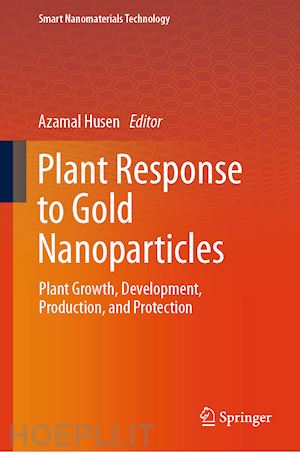
Questo prodotto usufruisce delle SPEDIZIONI GRATIS
selezionando l'opzione Corriere Veloce in fase di ordine.
Pagabile anche con Carta della cultura giovani e del merito, 18App Bonus Cultura e Carta del Docente
In this book, overall plant and soil system are examined exclusively in terms of gold nanoparticles (Au-NPs) exposure. Au-NPs influence plant growth and yield performance. They also affect plant and soil system interactions. Au-NPs responses are primarily depends on the concentration, plant species or cultivars, exposure time, shape and size of NPs. Investigation have shown that the lower concentrations of Au-NPs increase seed germination, beneficial biochemical components, rate of photosynthesis, and overall growth, however, at higher concentrations, all these responses are declined in different plant species. At higher concentration, Au-NPs induce stress in plant, create phytotoxicity and produce reactive oxygen species which leads to the disruption of cellular metabolism. Further, at higher concentration, Au-NPs hampered the physico-chemical process of plant and soil system. Moreover, the molecular and physiological performance showed that the exposure of Au-NPs resulted in oxidative stress and induced antioxidative and defense responses. The energy production related to metabolic pathways were also influenced by Au-NPs exposure. Au-NPs exposure accelerated the number of chromosomal aberrations, micronuclei, and decreased the mitotic index in plant root tip cells. Proteomic study has shown that the exposure Au-NPs resulted in an accumulation of protein precursors, indicative of the dissipation of a proton motive force. Au ions were noticed in roots and shoots, while Au-NPs were absorbed only in the plant root tissues. Au-NPs exposure also influence flowering process and seed germination. Beside the terrestrial plants, these particles have also influenced the growth of some wetland and aquatic plants. It was also noticed that the addition of Au-NPs into the culture medium had also influence the in vitro development and multiplication of plants. Studies have begun to examine how arbuscular mycorrhizal fungi might affect the uptake of specific nanoparticles include Au and how these particles might influence the plant-mycorrhizal relationships. The impact of Au-NPs on the size and structure of microbial communities in soil; and soil enzymatic activities for ß-glucosidase, urease, alkaline phosphatase, and dehydrogenase has been examined. In the present book, environmental safety, and ethical issues related to use of Au-NPs in plant and soil system has been also explored. Overall, this book is provide an up to date, most important and selected information associated with the plant response to Au-NPs. This book will be a good resource for upper-level students, faculty, scientists, and researchers working specially on plant biology, plant nanobiotechnology, plant biochemistry, plant microbiology, agricultural and other allied subjects and or science.
1. Plant response to gold nanoparticles in terms of growth, development, production and protection An overview.- 2. Beneficial and adverse effects of Au-NPs on plant.- 3. Genotoxicity of gold nanoparticles in plants and underlying mechanisms.- 4. Effect of gold nanoparticles on seed germination, plant growth and plant protection.- 5. Gold nanocomposites for improved plant-soil system and underlying mechanism.- 6. Proteomic insights into the impact of Au-NPs on plants under abiotic stress.- 7. Beneficial and adverse effects of gold nanoparticles on rhizosphere biology.- 8. Beneficial and adverse effects of Au-NPs on plant.
Azamal Husen is a Professor at Sankalchand Patel University, Visnagar, India; and Adjunct Professor at Graphic Era (Deemed to be University), Dehradun, Uttarakhand, India. He is also working as a Visiting Professor at University Putra Malaysia, Selangor, Malaysia; and acting as a Foreign Delegate at Wolaita Sodo University, Wolaita, Ethiopia. Previously, he served as Professor and Head of the Department of Biology, University of Gondar, Ethiopia. He also worked as a Visiting Faculty of the Forest Research Institute and the Doon College of Agriculture and Forest at Dehra Dun, India. His research and teaching experience of 25 years and contributed to R&D projects of the World Bank, ICAR, ICFRE, JBIC, etc. To his credit are >300 publications. He is Editor-in-Chief of the American Journal of Plant Physiology, and a Series Editor of Exploring Medicinal Plants (Taylor & Francis Group, USA); Plant Biology, Sustainability, and Climate Change (Elsevier, USA); and Smart Nanomaterials Technology (Springer Nature, Singapore).











Il sito utilizza cookie ed altri strumenti di tracciamento che raccolgono informazioni dal dispositivo dell’utente. Oltre ai cookie tecnici ed analitici aggregati, strettamente necessari per il funzionamento di questo sito web, previo consenso dell’utente possono essere installati cookie di profilazione e marketing e cookie dei social media. Cliccando su “Accetto tutti i cookie” saranno attivate tutte le categorie di cookie. Per accettare solo deterninate categorie di cookie, cliccare invece su “Impostazioni cookie”. Chiudendo il banner o continuando a navigare saranno installati solo cookie tecnici. Per maggiori dettagli, consultare la Cookie Policy.